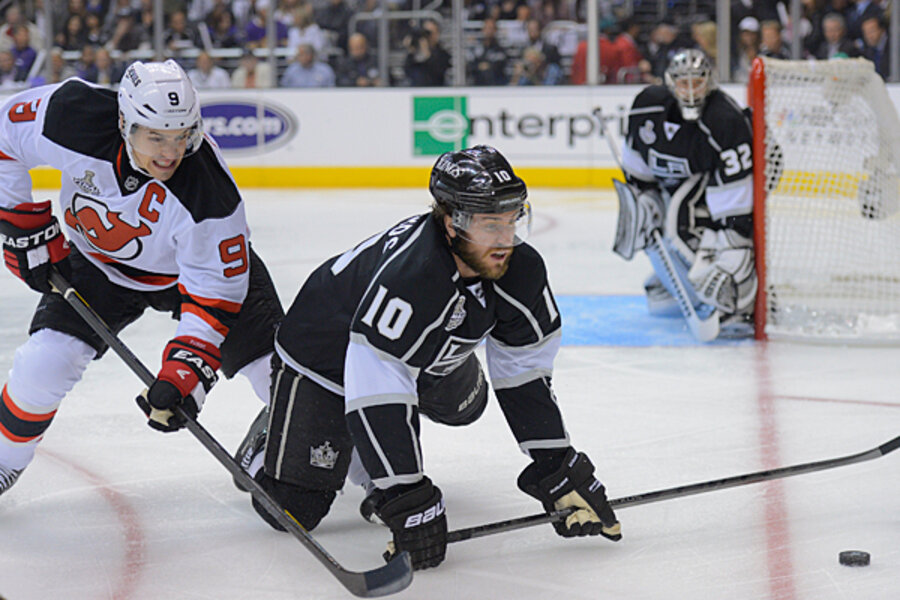Are the L.A. Kings the worst thing to happen to hockey?
Loading...
It seems as if no matter how the NHL tweaks hockey to open up the play so that offensive stars can shine, the game still manages to devolve into random tedium as the Stanley Cup playoffs progress, much as it has in the current finals matchup between the Los Angeles Kings and the New Jersey Devils.
The Kings – an eighth seed in the West that rode an octopus-like goaltender, Jonathan Quick, and near-flawless team defense to the cusp of a Stanley Cup victory (going 15-2 in the playoffs and winning Game 3 against the Devils Monday) – play a style of hockey that has met with a certain derision. The team has come to epitomize a lockdown mentality that takes the air out of the room, and the scoring out of the game.
The Devils can’t really argue with the Kings’ strategy, which relies on big, high-skill players lining up two or three deep in front of the net to deflect pucks, and on corralling bounces for quick rushes and scoring chances at the other end. The Devils themselves were criticized in the 1990s for use of the neutral zone trap, in which players guarded the boards and clogged up the middle of the ice so that opponents struggled even to get close to the net, where future Hall of Fame goalie Marty Brodeur lurked for clean-up duty.
This year, the chief culprit is what some perceive to be overuse of one of the most gutsy plays in hockey: the shot block, in which the defender eliminates elite scoring chances by basically diving in front of a 4-inch-wide, 6-ounce rubber mallet rocketing inches off the ice at 90 miles per hour.
Though the New York Rangers epitomize this tactic, they got bounced by the Devils in the Eastern Conference finals. L.A., meanwhile, has perfected a jittery, block-ready defensive zone trap that gives New Jersey’s star forwards precious little wiggle room and makes most scoring chances a hope for the best – a pinball, instead of an actual skilled play.
The result: “It comes down to a bounce…. It’s not going to be pretty, and it won’t be much fun,” writes Sam Fels, a Chicago Blackhawks blogger, on the NBC Los Angeles website.
Los Angeles blew past the Devils 4-0 in Game 3 on Monday, but previous matches had been low-scoring and even tedious. The first two games went to overtime, but there was little of the flow and go, run and gun that had dominated the playoffs' early rounds, in which every team with more than 100 points on the season was eliminated. Hence, the finals fell to teams that proved they could play defensive games studiously and consistently.
“Low-scoring games typically go to overtime, connoting the notion of excitement and parity when it is instead gridlock and stalemate,” groans Canadian hockey writer Bruce Dowbiggin, of The Globe and Mail, in a column. “Change the names and jerseys and very few would notice. The league’s Hockey Operations department wants it thus. Coach’s Corner likes it thus. The networks grudgingly go along. What choice do they have?”
NBC can't be happy, though. Viewership for Game 2 was 2.54 million, down from Game 1's 2.9 million – a five-year low. The History Channel's "Swamp People," with 4.85 million viewers, beat Stanley hands down on the kickoff night of the finals.
Hair-tearing hockey fans have already come up with numerous prescriptions, as they are wont to do. Some say to penalize shot blocks that involve kneeling or lying down on the ice. Others suggest a basketball-court-like “key” in front of the net, which only two defensive players can patrol.
None of that will happen, of course. Using less draconian changes – making the offensive zone a few inches bigger, limiting the size of goalie pads, getting rid of the two-line pass rule – the NHL has managed to speed up the game and boost scoring since the 2004 lockout. One result: a $1 billion, 10-year deal with NBC, which goosed ratings this playoff season by showing every game and using top-notch producers to promo the game and its stars.
Before the latest criticism, the concern was – not for the first time – that violence and brutality are what sparked high viewership in the early rounds, another indication of hockey’s perennial high-wire act between sportsmanship and bloody knuckles, between the push for more goals against the bottom-line goal of winning a Stanley Cup, by whatever scheme necessary.
When hoisting the Stanley Cup is on the line, the idea that players and coaches, whether the Kings or anyone else, should abandon their recipe for success to titillate fans seems quaint, even misguided. That may be especially true with shot-blocking, which for hockey players, and many fans, is the ultimate act of sacrifice and courage, and which has its perils, including a high risk of serious injury to key players.
In that light, as the 2012 Stanley Cup season is again showing, the finals ultimately are about the players, who at this point have only guts and grit to work with after a grueling, body-smashing season that extends to nearly 100 games over eight months.
Rangers coach John Tortorella, in his inimitable style, said as much when punching back against criticism that his team had overrelied on shot blocking to the detriment of high scoring.
“The people that are writing about us with our shot blocking … I think they’re idiots,” Tortorella told NBC’s Bob Costas recently. “Blocking shots is part of playing proper defense, and we’ve got a couple of guys covering our team that don’t get it. And that really upsets me. Not for myself, but for the players that do it. It’s part of us. It’s part of what these guys want to do.”






